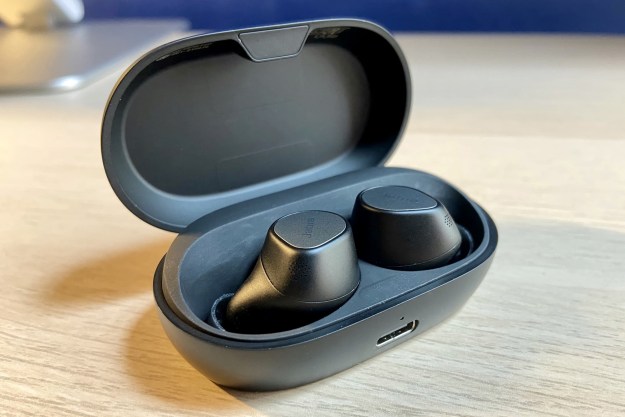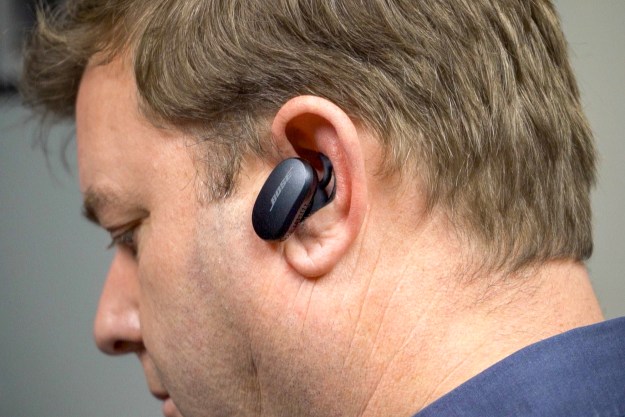- Wonderful picture; quality audio; deep blacks; non-reflective; built-in image optimizer
- Wildly expensive; ho-hum remote; no SD card reader
Summary
We get bleary-eyed checking out all the new HDTVs. Bigger, better and cheaper are this year’s watchwords in a nutshell. And yet, if you walk into a decent retailer (i.e. Magnolia in your local Best Buy) and gaze over a wide expanse of higher-end flat panels, one series always stands out: Pioneer’s Kuro plasma HDTV line. Consistently rated by everyone with 20/20 vision as the best available, we couldn’t wait to put the new Elite Pro-111FD through its paces. Although wonderful, though, one huge drawback for the product family is the simple fact that featured selections are wildly-expensive compared to plasma market-share leader Panasonic’s offerings.
For example: A top-end (and very good) 1080p 50-inch Panasonic TH-50PZ850U is $2,999 and the entry-level 1080p TH-50PZ80U is $2000 (it’s not too shabby either). The same-sized Kuro? Try $5,000 for a top-end Elite or “only” $4,000 for a plain vanilla Pioneer. And this, before we even consider manufacturers like Vizio, who offer similar-sized models for around $1,500. But hey, what can we say: Even in this horrible economic environment, it’s still nice to dream of have the scratch to purchase a luxury HDTV. Hit the jump to see how well this new set fared…
Features and Design
Like all flat panel TVs, Pioneer Kuros come in a large upright carton. Unlike most other models, the speakers are not built into the frame; you literally have to attach them with brackets and connect the speaker wires via clip connections—something more befitting a boombox than a $5,000 HDTV. We won’t rag on Pioneer too much for this, however, since most purchasers of this set will use it as a centerpiece of a kick-butt home theater system with the requisite A/V receiver and five speakers plus a subwoofer.
Connecting the speakers is just a matter of tightening 16 Philips-head screws and takes about 10 minutes. This model is also supplied with a color sensor that gets attached by a magnet to the lower right corner of the frame. This sensor measures ambient room light and automatically adjusts the picture when you’re in the Optimum mode (more on this in the Performance section).
Once assembled, the Pro-111FD looks elegant on its integrated non-rotating stand with its subtle gloss black finish. The only visible logo is a golden “Elite” on the lower bezel. On the lower left corner of the frame are tiny power indicator lights, while in the lower right corner are sensors for the remote, room light and color. (We’ll get into these in the Performance section as well.) The power on/off button is located under the frame and there’s no front compartment for game console or camcorder connections either. There are just smooth, unbroken lines on the frame. As we said – it’s elegant and subtle.
Moving along, the Kuro is a lot thinner than previous editions, breaking the 4-inch barrier. It weighs 88 pounds including the speakers, panel and stand. The panel itself measures approximately 57 inches wide with the speakers, 28.5 inches tall and 3.65 inches deep. There are two recessed handles on the back so you can carry and position it fairly easily.
The rear of the set is logically designed with enough inputs to handle most A/V setups as well. There are 3 HDMI ports on the back with a fourth on the side, component video, an analog RGB PC input, Ethernet, S-video, speaker terminals, audio, subwoofer and optical digital audio out, and so on… you get the idea. On the left side—along with HDMI connectors—are USB and headphone inputs as well as channel/volume up/down controls. You’ll rarely use these commands though, as they’ll mostly be handled via remote. Unfortunately, there’s no SD card slot to playback JPEGs or AVCHD videos like those found on Panasonic’s competing offerings. Pity.
The Rear Panel of the Pro-111FD
The supplied remote is pretty straightforward with keys grouped in logical sections. Keep in mind that it’s a learning remote as well, so you can eliminate the gaggle of other remotes piling up on your couch (for satellite or cable box, BD player and so on). Of course, it’s also a fairly basic remote and we were surprised that Pioneer didn’t include a much sexier one with an LCD touchscreen similar to a Harmony One. But hey, we guess that sort of advanced controller is an “add-on” profit opportunity for Pioneer Elite retailers. Still, you’d think five Gs would buy a little more…
What’s In the Carton
The Pro-111FD comes with everything you need to set it up other than a screwdriver and HDMI cables. You get the remote, cleaning cloth, color sensor, speakers and speaker wire, various brackets, cable clamps and screws. It’s also supplied with a very nicely crafted, 166-page owner’s manual that does double duty for the -111FD and its larger 60-inch sibling, the $6,500 Pro-151FD.
Once the set was assembled, it was time to connect some high-def components to see just how well it performed.
Image Courtesy of Pioneer
Performance
Before getting into our tests, a few quick observations.
Even turned off, the Kuro gives a big hint as to its quality. Compared to other plasmas, there’s barely a hint of reflected light—and we set this up in a room with mixed lighting including florescent bulbs. Reflectivity is a real bugaboo with plasmas, since their displays use multiple layers of glass unlike LCD screens. That’s why we typically recommend an LCD if the set is used in a room with loads of windows and daylight. That isn’t the case at all with the Kuro—and, to a lesser degree, any new Panasonic plasma with a special anti-reflective coating.
Another big hint that speaks volumes is the fact that the set’s screen is very dark with the power off. Most others are lighter shades of gray. What this points to are excellent black levels, the foundation for great color. But we’re getting ahead of ourselves…
Equipment Setup
We used two key components to test the Pro-111FD—a Verizon FiOS HD/DVR cable box and a Panasonic DMP-BD30 Blu-ray Disc player. Before getting into some HD video, we had to put the Kuro through its initial set-up phases.
Since picture quality is what any HDTV all about, we spent a long time working through the Picture options. As the supposed king of plasma sets, the Kuro has extensive adjustment options including Optimum, Performance, Pure, Movie, Sport, Game and Standard. There are also ISF Day/Night features for those who want an outside pro to calibrate their sets. Under most of the settings are extensive submenus that let you tweak the image to your liking, or follow a DIY disk like Digital Video Essentials or Monster’s HDTV Calibration Wizard. When you’re making the adjustments, you can quickly compare tweaks when you hit the “tools” key on the remote to see before and after results.
Optimum is a very cool option and was our overall preferred choice here. It automatically adjusts the picture depending on the brightness of the room using the Room Light and Color Sensors. Pure is another good one, since it faithfully reproduces the signal sent to the screen. Of course, you can adjust a gadget freak’s worth of picture parameters, screen sizes and so on, with such modifications taking up entire chapters of the Owner’s Manual. Into Gamma and Color Space? You can make all the adjustments you’d like. Whoever thought watching a television was so complicated? (Actually it’s not, and after doing our own tweaks, we chose Optimum for watching HD channels and Blu-ray discs.)
Pioneer also knows men and women do not live on video alone, so they added a number of SRS TruSurround settings. We had gone through the trouble of attaching the speakers so this circuit was engaged as well.
Image Courtesy of Pioneer
Verizon FiOS HD
Verizon’s FiOS service delivers some of the best quality HD signals available—and don’t worry, we pay for it like everyone else, so this is an unbiased opinion. The ESPN HD feed sparkled and skin tones looked as natural as can be—not too vivid or unreal. NFL games also dazzled, and since it’s a plasma set, there’s never any issue with streaking or blurring. You don’t have to worry about response time or if the LCD uses 120Hz technology either—plasma was always way ahead of the game, and this set helps it maintain the lead.
Blu-Ray Movies
We were really impressed watching some ultimate fighters on HD Net—the skin colors, bright white mat (and, yes, even gore)—were extremely impressive. Moving to The Hills Have Eyes II, we could really see the Kuro at its best. In the one scene where the heavily-armed heroes drop into a well and the camera looks up to the night sky, the black was as inky as could be. In that creepy montage, you could easily see all the details in the shadows. Mind you, the movie was awful, but we’ve got no complaints about picture quality.
Switching to the Blu-ray player, we again used the Optimum setting and the Smooth setting in the PureCinema menu. Once done, we popped in the new Iron Man disc as well as few other favorites. Kuros have a deserved reputation for outstanding black levels, and Iron Man offered some great examples—especially when Tony Stark takes flight for the first time during a nighttime journey through the L.A. skies and past a Ferris wheel. It was a dense, inky black and lights just sparkled off the screen. The movie just looked great and even sounded quite good with the SRS delivering a decent ersatz surround effect. Other discs such as Happy Feet and Night At the Museum also proved equally engaging. We never thought that penguin feathers, or Robin Williams’ mustache, could look so detailed.
While watching various flicks, we’d also change room lighting, even turning on the overhead fluorescents just to check the results. The Kuro did not skip a beat, and there was barely a hint of reflection: Impressive results indeed. But overall, the Pro-111FD is one impressive HDTV, and it’s easy to see why it remains a standout in a sea of lesser-performing rivals.
Conclusion
There’s no question that the Pioneer Elite Kuro Pro-111FD is a new benchmark for plasma HDTVs—picture quality is that good. Thus, if money is no object, buy without reservation and you’ll be in video heaven for years to come.
But realistically, how many of us are in this situation? Even Sergey Brin and Bill Gates are watching their pennies now. If budgets are tight, the Panasonic 800 series remains a worthy alternative, but realize that the ultra-deep Kuro blacks aren’t there. Nonetheless, these sets are much better than 95% of the LCD HDTVs available (other than the new LED backlit models from Sony and Samsung, but they’re a cool $4/5K as well for 50-inchers).
In other words, with big screen flat panel HDTVs, if you want the best, you’re going to have to pay for it. Whether the Elite Kuro Pro-111FD is worth taking the plunge is the $5,000 question. The answer being that, if it were up to us, we’d definitely start saving our pesos or look for a retailer with 0% financing, since the set is that good.
Pros:
• Fabulous 1080p picture
• Deep blacks
• Little reflection of ambient room light
• Built-in image optimizer
Cons:
• So darn expensive
• Remote should be more sophisticated
• No SD card reader
• Did we mention that nosebleed price?
Editors' Recommendations
- Pioneer’s latest budget-friendly Dolby Atmos AV receivers start at $379
- Best Buy expands its affordable Xumo TV lineup with Pioneer-branded models
- NuraTrue Pro hands-on review: A sneak peek at the lossless future of wireless audio
- Jabra adds Bluetooth Multipoint to Elite 7 Pro/Active earbuds
- Jabra Elite 7 Pro vs. Sony WF-1000XM4






